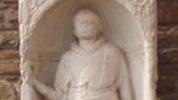Archaeology and Ancient History
Gill's dissertation
Male Identities in the Roman Provinces of Britain and Germany in the 1st – 3rd Centuries CE: A Comparative Analysis
Why did you choose this topic?
We all have multiple, intersecting identities, which help to make us who we are. I chose this topic because I wanted to explore what identities were sufficiently important to people in the past to be displayed publicly and what this might tell us about the societies in which they lived.
What did you write about?
 I analysed evidence from monuments and items of personal appearance, such as belt-plates, weapons and armour, to identify the male identities visible in Roman Britain and Germany. Men's identities as husbands, fathers and sons were visible on many tombstones. Other identities were associated with privilege or power; for example, men were sometimes portrayed on monuments wearing the toga, which was linked to Roman governmental authority and symbolised Roman citizenship, which conferred political, occupational and legal advantages.
I analysed evidence from monuments and items of personal appearance, such as belt-plates, weapons and armour, to identify the male identities visible in Roman Britain and Germany. Men's identities as husbands, fathers and sons were visible on many tombstones. Other identities were associated with privilege or power; for example, men were sometimes portrayed on monuments wearing the toga, which was linked to Roman governmental authority and symbolised Roman citizenship, which conferred political, occupational and legal advantages.
Other tombstones displayed professional identities by showing equipment associated with a skilled occupation, such as a shipper, architect or builder, or indicated a man's success in life by identifying him as a former slave, who had been freed and granted citizenship. There is also some evidence that slaves, despite their low status, had professional identities, for example as a secretary.
The appearance of civilians, who were usually depicted wearing unbelted tunics, contrasts with that of infantry soldiers, whose tombstones featured decorated belts from which their swords and daggers were prominently suspended. This suggests infantrymen constructed an identity as professional Roman soldiers, which clearly differentiated them from male civilians, who were normally forbidden to carry weapons. Other military groups, for example cavalrymen, centurions and standard bearers, also displayed distinctive identities.
The tombstone of the infantry soldier, Firmus, from Andernach, Germany, illustrates some of these contrasting identities. The largest figure is Firmus, shown with his cloak thrown back to display his crossed belts, military 'apron', sword and dagger. The smaller figure on the right wears a toga, and was possibly his heir and a Roman citizen. The smallest figure on the left is his slave Fuscus, who carries a bag and wears the cloak and tunic that were the everyday clothing of men in Roman Britain and Germany.
Compared with Britain, tombstones from Germany provide more evidence of civilian professional identities, and the new identities as Roman citizens and legally-recognised husbands and fathers that were often granted to army veterans on discharge from the armies. Cavalrymen's tombstones from Britain focused to a greater extent on military identities linked to violence and victory in battle, while their German counterparts emphasised wealth. This suggests at least the possibility of a deeper divide between soldiers and civilians in Romano-British society than in Romano-German society.